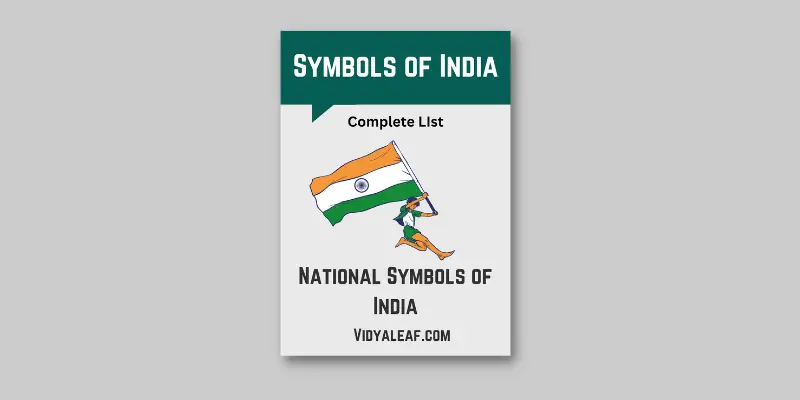In this article, we have given details regarding the National Symbols of India and also provided the List of National Symbols of India. In a competitive exam, many questions related to National Symbols have come up. That’s why the List of National Symbols of India is essential for candidates preparing for competitive exams.
National Symbols of India
India has many national symbols that have been officially adopted, including the constitution, the flag, and the lion capital of Ashoka among others. It also has several unofficial ones that are still accepted as representative of the country and its people. Among these are names of different festivals like Holi and Deepavali, national heroes like Mahatma Gandhi and Mother Teresa, animals like the tiger and peacock, birds like the parrot and eagle, and so on.
List of National Symbols of India PDF
Here is the complete list of National Symbols of India. Let’s take look at the National Symbols of India List.
| Title | National Symbols |
|---|---|
| National Flag | Tiranga |
| National Anthem | Jana Gana Mana |
| National Calendar | Saka calendar |
| National Song | Vande Mataram |
| National Emblem | National Emblem of India |
| National Fruit | Mango |
| National River | Ganga |
| National Animal | Royal Bengal Tiger |
| National Tree | Indian Banyan |
| National Aquatic Animal | Ganges River Dolphin |
| National Bird | Indian Peacock |
| National Currency | Indian Rupee |
| National Reptile | King Cobra |
| National Heritage Animal | Indian Elephant |
| National Flower | Lotus |
| National Vegetable | Pumpkin |
| Oath of Allegiance | National Pledge |
National Flag of India
The National Flag of India is a horizontal rectangular tricolor of deep saffron, white and green; with the Ashoka Chakra, a 24-spoke wheel, in navy blue at its center. It was adopted in its present form during a meeting of the Constituent Assembly held on 22 July 1947, when it became the official flag of the Dominion of India. The flag was subsequently retained as that of the Republic of India.
Emblem of India
The Emblem of India is an adaptation of the Lion Capital of Ashoka at Sarnath, preserved in the Sarnath Museum in Uttar Pradesh. The capital was erected by Emperor Ashoka in the 3rd century BC.
Song of India
The Song of India, also known as Vande Mataram, is one of the national symbols of India. The song was written by Bankim Chandra Chatterjee in 1876 and was first published in Anandamath. The song is included in the national anthem of India, Jana Gana Mana. Vande Mataram has been translated into many languages and is sung all over the world.
Anthem of India
The National Anthem of India is Jana Gana Mana, which was composed by Rabindranath Tagore. The song was first sung on December 27, 1911, at the Calcutta Session of the Indian National Congress. The lyrics of the anthem are based on Bengali and Sanskrit. The anthem has five stanzas, and the first stanza is sung as the national anthem.
Calendar of India
The National Calendar of India is based on the Saka Era, which begins in 78 AD. The Saka Era is a lunisolar calendar, and so the National Calendar takes into account both the solar and lunar cycles. The first day of the National Calendar is April 14, which is also the start of the Vikram Samvat era. This era is named after King Vikramaditya who ruled from Ujjain.
National Fruit of India
The National Fruit of India is the mango. The mango is a symbol of Indian culture and tradition. The mango is also a symbol of India’s national identity. The mango is a delicious fruit that is enjoyed by many people all over the world. The mango is a nutritious fruit that is rich in vitamins and minerals.
National River of India
The National River of India is the Ganges. The Ganges is considered holy by Hindus and is a lifeline to millions of Indians who live along its course and depend on it for their daily needs. It is also home to many rare and endangered species of animals, birds, and fish. The river has been declared the National River of India.
National Animal of India
The national animal of India is the tiger. The tiger is a powerful and majestic animal that is revered by many. The tiger is also an endangered species, and there are only a few thousand left in the wild. The national animal of India is a symbol of strength, power, and beauty.
National Tree of India
The national tree of India is the banyan tree. The banyan tree is a large, sprawling tree that is native to the Indian subcontinent. The banyan tree is considered sacred in Hinduism and Buddhism, and it is often found growing near temples and shrines. The banyan tree is also the national tree of Bangladesh.
National Aquatic Animal of India
The National Aquatic Animal of India is the Gangetic Dolphin. These dolphins are found in the Ganges-Brahmaputra-Meghna and Karnaphuli-Sangu river systems of Nepal, Bangladesh, and India. They are an endangered species and are protected under the Indian Wildlife (Protection) Act, 1972.
National Bird of India
The national bird of India is the peacock, which is a large and brightly colored bird. The male peacock has blue and green feathers, while the female has duller colors. The peacock is a symbol of beauty, grace, and good luck. In Hindu mythology, the god Krishna is often depicted with a peacock feather in his hair. The national bird of India is also the national animal of Sri Lanka.
National Currency of India
The national currency of India is the Indian rupee. One rupee is divided into 100 paise. The rupee is named after the silver coin, Rupiya, first issued by Sultan Sher Shah Suri in the 16th century. The word Rupiya comes from Sanskrit Rupya, meaning wrought silver. The Monetary Policy Committee sets the official interest rate.
National Flower of India
The national flower of India is the lotus. It is a sacred flower and has been associated with Indian culture for centuries. The lotus symbolizes beauty, purity, and spiritual awakening.
National Vegetable of India
The National Vegetable of India is the pumpkin. It was chosen because it is a versatile vegetable that can be used in a variety of dishes. Plus, it is a nutritious vegetable that is high in fiber and vitamins A and C. The pumpkin is also a symbol of fertility and abundance, making it the perfect choice for the National Vegetables of India.



